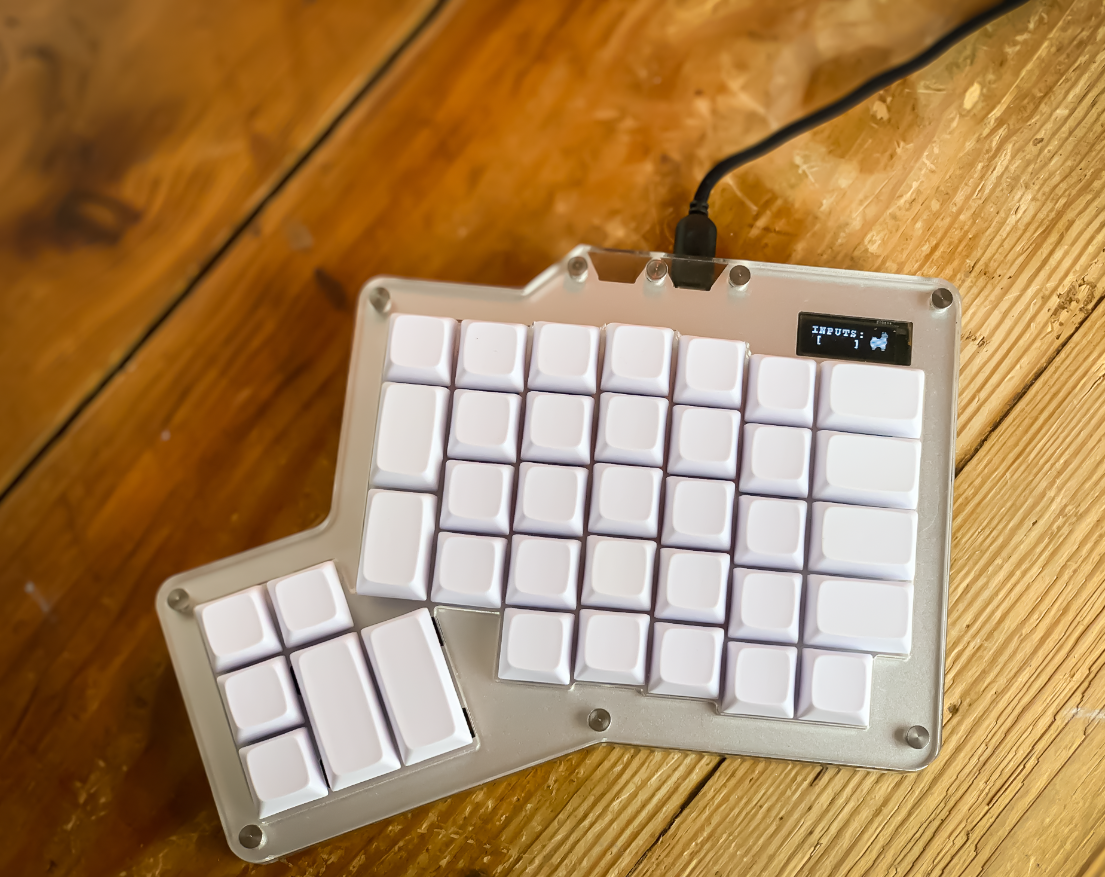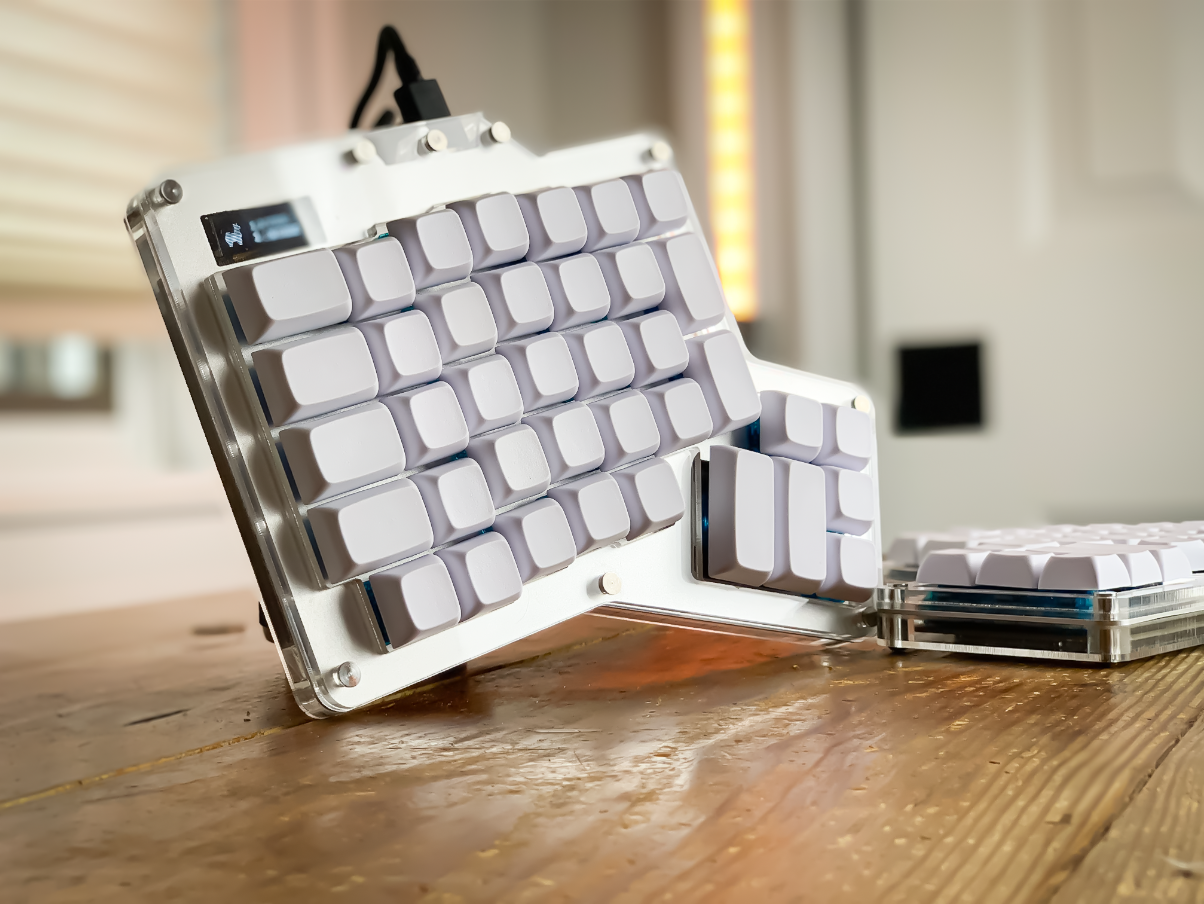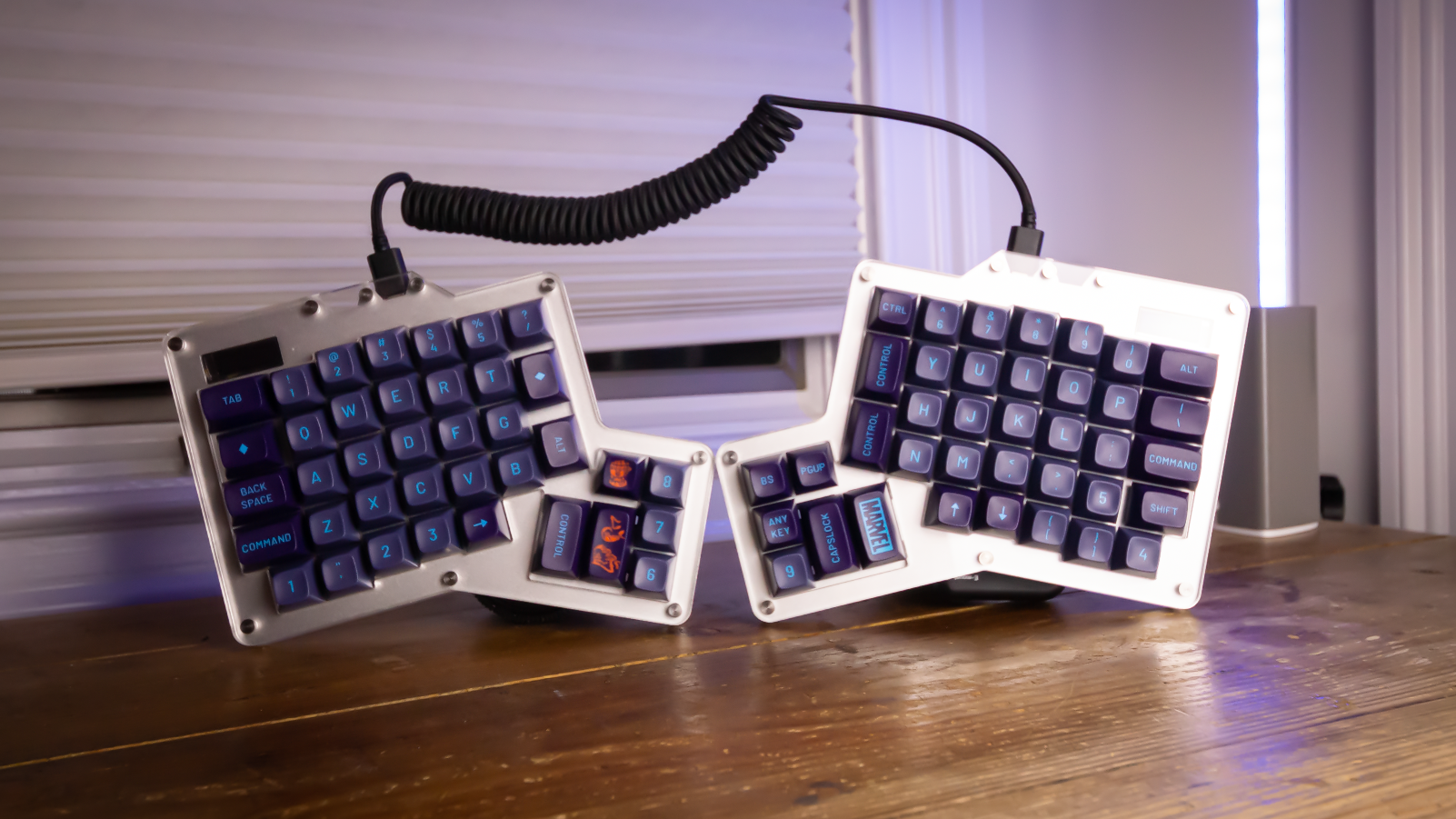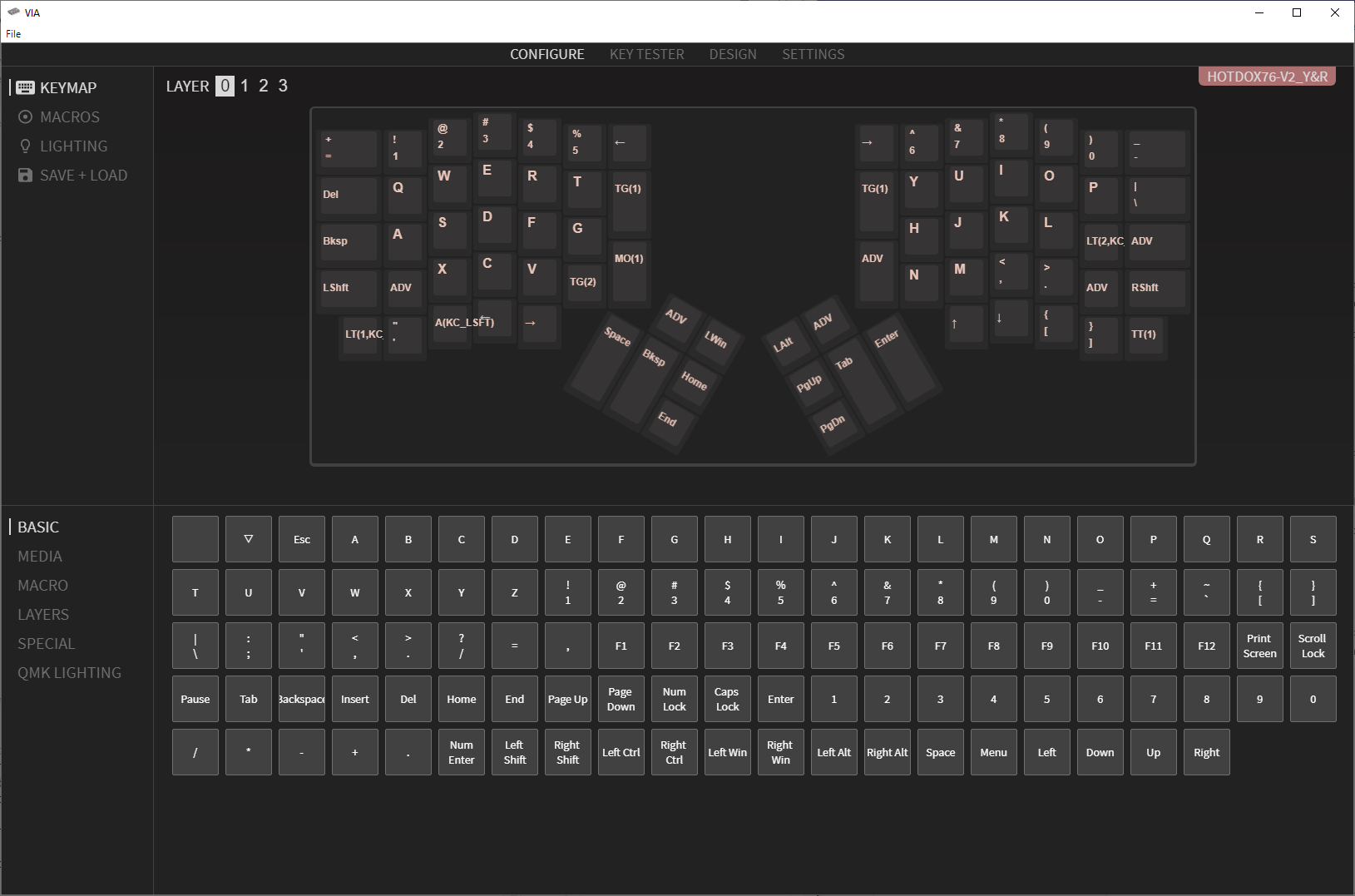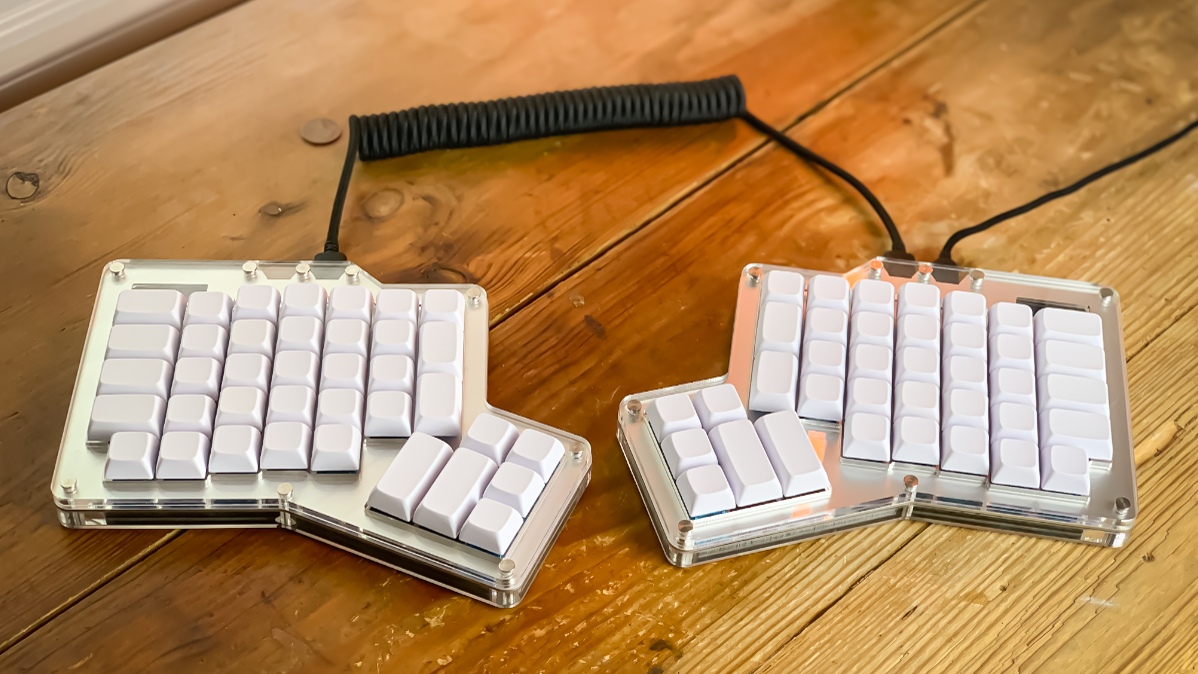Tom's Hardware Verdict
The ErgoDox 76 makes ergonomic layouts more accessible with a cheaper price and hot-swappable switches, plus its got screens for extra bling. Still, ergo layouts aren’t for everyone.
Pros
- +
+ Translucent acrylic case
- +
+ QMK/VIA support
- +
+ Hot-swappable with 5-pin support
- +
+ Fair price
- +
+ LED screens have alpacas on them
- +
+ Surprisingly good for gaming
Cons
- -
No stabilizers
- -
USB connection doesn’t feel secure
- -
Blank keycaps
Why you can trust Tom's Hardware
A standard rectangular keyboard is the center of any desk. But while it may allow you to get your work done, you run the risk of developing repetitive strain injury (RSI) with it. RSI is an extremely painful form of tendonitis that derives from many things: for example, typing. The ErgoDox layout, originally developed as an open-source project, attempts to get rid of that risk with a split mechanical keyboard that helps prevent RSI due to its two-piece design. It’s since been commercialized as the fairly expensive ErgoDox EZ, which starts at $354, but it’s free for other companies to use as well.
Enter the Alpaca Keyboards ErgoDox 76 “Hot Dox” V2, which takes a cheaper but still impressive approach to the ErgoDox layout, plus adds some hobbyist appeal with hot-swappable switches.
Alpaca Keyboards ErgoDox 76 'Hot Dox'
| Switches | Hot swappable, sold separately. Reviewed with Kono Midnight switches. |
| Lighting | One zone RGB |
| Onboard Storage | 4 |
| Media Keys | Programmable |
| Connectivity | USB Type-C |
| Cable | 1x 6 inch coiled cable |
| 1x 6 feet braided cable | |
| Additional Ports | 2X USB Type-C (One is occupied to power the ErgoDox) |
| Keycaps | Blank DSA |
| Software | QMK/VIA |
| Dimensions (LxWxH) | Each half of the keyboard is: 5 x 7 x 0.5 inches (127 x 177.8 x 12.7mm) |
| Weight | 2.8 Pounds |
Design of the ErgoDox 76
The ErgoDox 76 Hot Dox V2 by Alpaca Keyboards is a split ergonomic mechanical keyboard, but has a few features onboard that cater to the DIY mechanical keyboard market, like a hot-swap PCB, an acrylic chassis and a layer indicator screen. It uses the open source ErgoDox layout popularized by the ErgoDox EZ, but like the original Hot Dox board, is significantly more affordable at a starting price of $195.
The ErgoDox layout was designed to promote ergonomics over long periods of typing thanks to its ortholinear key spread and split design. If you look at the key rows on most keyboards, you’ll notice that they’re straight, and even though this works, it isn’t ideal for long-term use. Ortholinear layouts are designed to line up with the length of your fingers to reduce finger travel. The board is also split into two halves so that your arms don’t have to bend inward for you to type.
The board’s two halves connect via USB Type-C and are powered by another USB-C cable that can connect to either the board’s left or right half. Unfortunately, connecting the board was a pain. The included coiled cable’s connectors are a tad too wide, making plugging them in awkward. I didn’t feel any sort of click or latching at all when connecting the ErgoDox. To be fair, I didn’t experience any disconnections during use, but I wish the connectors were skinnier at the end.
When you have a keyboard with such a non-traditional layout, keycaps aren’t as easy to come by as they are for any other mechanical keyboard. However, there are workarounds since many ergo keyboard users will use 2u keycaps (keycaps that fit over two switches) for functions like backspace or shift, but this can look awkward. Since the Hot Dox comes with blank keycaps, I took keycaps from another board of mine after a few hours of use, and even though it looked strange, it made typing less frustrating.
Switches aren’t included with the base Hot Dox V2 (you can opt to pay more for either Kailh Speed Copper or Kailh Rose Red switches), which prides itself on being hot-swappable. But underneath the keycaps on my review unit were Kono Midnight tactile switches. These are advertised by the store selling the Hot Dox as going especially well with this board. The Midnight switches are produced by JWK, like the other Kono switches we looked at in another review. When I started the board up, I noticed that some keys weren’t inputting, so I got my keycap and switch puller to find out that some of the switches had bent pins. For me, this was an easy fix: just bend the pins back with precision tweezers. However, this bothers me because it shows that Kono didn’t do a quality check before shipping this board out. This won’t be an issue for you if you buy the base version of this board, but we can’t speak to how the two options with switches included will ship.
Get Tom's Hardware's best news and in-depth reviews, straight to your inbox.
The Hot Dox’s case is composed of stacked acrylic, which looks and sounds fantastic during typing. It’s very light, so it’s good to know that the retail version of this board will have rubber bumpons to stop it from sliding around (mine didn’t).
If you look underneath the board, you’ll see the PCB and the hot-swap sockets, which I thought was a neat touch. However, because the case is acrylic, it can scratch more easily than most other non-metal cases. I didn’t really see any noticeable scratches on my unit’s case, but you may want to invest in some acrylic polish if you plan on buying this board.
Two features are blowing up in popularity on the DIY mechanical keyboard market: rotary knobs and LED screens. While the ErgoDox doesn’t have a rotary knob, it does have an LED screen on the left and right sides. When the keyboard is turned on, the screen displays a little Alpaca along with the characters you’re inputting.
The Alpaca Keyboards ErgoDox features RGB, but it isn’t on a per-key basis. Overall, it seems to be a bit of an afterthought because this keyboard is using QMK/VIA for its software, so RGB capability is limited.
Typing Experience on the ErgoDox 76 Hot Dox
Typing with the Hot Dox made me feel like I was in my third-grade typing class again because that's how slowly I was typing with this board.
Getting used to typing with this board was very tricky for me, and I couldn't enjoy it because I didn't want to re-learn how to type. Nonetheless, I used the ErgoDox for a few days and started to find my rhythm, but I concluded that this board wasn't for me because of its steep learning curve. Don't get me wrong; this doesn't mean that this board is bad because it isn't. However, retraining your muscle memory for an ergonomic layout takes time, and I know that if I had more time for this review, I could get used to it like with any other plank. As a matter of fact, a close friend of mine uses an ErgoDox layout at his job and swears by it.
Comfort is key with an ergonomic keyboard, and the spherical, low-profile DSA keycaps that came with this board, while they were blank, go hand-in-hand with the ergonomic design. DSA keycaps are nothing like the usual OEM or Cherry profile keycaps because they're flatter and sit lower than most keycap profiles and the height is the same for every row. I understand why they're blank here, as this board is designed to be configured in the weirdest of ways, but would it be too much to ask for A-Z legends? I liked these keycaps, but felt the need to replace them due to the lack of legends on an already unusual layout.
This board's acrylic case acted like a cheat code when it came to sound because there isn't any dampening material in the ErgoDox, yet there was no case or spring ping during my testing. Since the case is acrylic, it also produces a deeper pitch when typing, which is what I prefer. I don't like high-pitched builds because they sound like a cheap prebuilt board.
The Kono Midnight tactile switches are sold separately but were installed somewhat properly on my unit. I'm usually a linear switch fan, but I really enjoyed these switches. The Midnights are far more tactile than the usual Cherry MX Browns and are much heavier with a weight of 69g as opposed to 45g in the MX Browns. These switches felt very similar in tactility to the CannonKeys Neapolitan Ice Cream switches. You'd have to buy these switches separately to use them on this board, but because it's hot-swap, you can recreate my experience if it sounds like it would appeal to you.
Because of the way the PCB is printed on the Hot Dox, if you want to use stabilizers in this keyboard, you'd need to buy a set of clip-in stabilizers. Clip-in stabilizers have blown up in popularity lately since they are dirt-cheap and easy to modify. A set of genuine Cherry clip-in stabs will only cost you $16 on Amazon, but for some reason, none came with this board. Granted, you can get away without using stabilizers since there's no 3u or spacebar here, but they would've been nice to see.
The ErgoDox 76 Hot Dox isn't my type of mechanical keyboard. I found it to be a chore to learn, but I do see it being practical for others, especially if you're into coding and don't want to extend your pink every time you need to press the shift button.
Gaming Experience on the Ergodox 76 Hot Dox
Gaming with the Hot Dox made me realize something – you usually only need half a keyboard at most to game. This time around, the game I chose was the newest game by FromSoftware: Elden Ring. Since this board is split, I could save a lot of space on my desk by only connecting one-half of the board to my computer. It's hilarious how well I played with this board despite my lack of ability to type a proper sentence with it 9/10 times.
However, the switches were far too heavy for a game like Elden Ring, where you need to get out of the way of attacks at a moment's notice. This only fueled my frustration over the game's difficulty, so you might want to consider at least giving WASD linear switches if you plan to occasionally use this board to game.
Still, buying this board means getting a free one-handed gaming keypad in the bargain.
Software
The Hot Dox is designed for comfort, so customization is critical. The software powering the split board is VIA, an open-source keyboard configuration software. I went in-depth on VIA in my review for the Keychron Q1, but it takes all of the features from the robust but complicated QMK, like “leader key,” which maps a key to write the word programmed to it making them easier to use. For instance, QMK requires you to flash your changes right to your board, but Via needs no such thing.
Oddly enough, the Hot Dox was laid out well in its default setup – the only changes I eventually made was to swap the position of the backspace key with the space key because I kept hitting backspace when I wanted to hit space and vice versa.
Since VIA allows for five layers of keybinds, I believe that this keyboard can be a coder’s dream. Depending on the coding language used, I can easily see a programmer dedicating an entire layer to specific characters.
The thing is, that’s just scratching the surface here. Because QMK/VIA are open-source software suites, there’s a lot of depth as to what you can program the Hot Dox to do.
Bottom Line
The Alpaca Keyboards ErgoDox 76 “Hot Dox” does a decent job of making the ErgoDox layout more mechanical keyboard enthusiast-friendly with its acrylic case, hot-swap PCB, LED screens and QMK/VIA support, plus it costs a fraction of the price of an ErgoDox EZ.
However, I wouldn’t buy this board because it’s not what I’m looking for – I’m not looking to improve my typing comfort, and this does take some relearning. Instead, I would recommend this keyboard for programmers and anyone who wants to try something new, as it’s an affordable way to branch out and find something that’s potentially healthier for you.

Myles Goldman is a freelance writer for Tom's Hardware US. He reviews keyboards and cases.
-
1_rick Huh. How'd you manage to lay hands on one of these? I ordered an Infinity Ergodox from Kono ages ago, and it was delayed so long that a few months ago they offered me the option to switch to the Hot Dox instead. The group buy supposedly ended early February and they're taking preorders for leftovers, but their update page doesn't even mention the Hot Dox yet, so I hope it's in production and will be done 2Q like they say, but have no way to know.Reply
